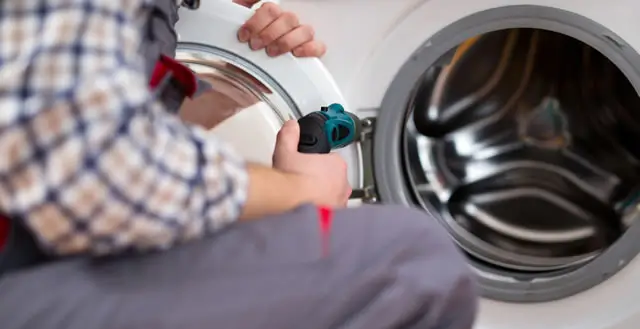What is more frustrating, a broken dryer or a broken washer? They are both frustrating, but a broken washer will give you more anxiety when it brings your laundry routine to a standstill. Most of the time, a broken washer can be diagnosed and fixed quickly if you know the right steps to troubleshoot it by yourself. This is why we wrote this article, to share some of these steps with you so you can diagnose your washer before calling an expensive washer repair company in your area.
Common Reasons Your Washer Won’t Fill
- Clogged or Faulty Water Inlet Valves: These valves control the flow of water into the washer and can become blocked or defective.
- Kinked or Damaged Hoses: The water supply hoses may be bent, restricting the flow of water.
- Blocked Filters: Filters inside the water inlet valves can accumulate debris over time.
- Low Water Pressure: Insufficient pressure in your home’s plumbing system can prevent the washer from filling properly.
- Lid Switch Issues: Many top-loading washers won’t fill if the lid switch is malfunctioning.
- Control Board or Timer Malfunctions: These components regulate when the washer should start filling with water.
- Faulty Pressure Switch: This switch monitors water levels and can stop the washer from filling if it’s defective.
Step-by-Step Troubleshooting Guide
1. Check the Basics
- Ensure the Washer Is Plugged In: Verify that the machine is receiving power.
- Confirm the Water Supply Is On: Make sure both the hot and cold water valves are fully open.
2. Inspect the Water Hoses
- Look for Kinks: Straighten out any bent hoses.
- Examine for Leaks or Damage: Replace damaged hoses to restore water flow.
3. Clean the Inlet Valve Filters
- Turn Off the Water Supply: Disconnect the hoses from the washer.
- Locate the Filters: These are typically inside the water inlet valves.
- Remove and Clean the Filters: Use a soft brush to clear away debris.
4. Test the Water Inlet Valves
- Check for Blockages: Inspect the valves for any clogs.
- Use a Multimeter: Test the valves for electrical continuity. If they’re defective, replace them.
5. Assess Water Pressure
- Test the Faucet Pressure: Run water from the faucet supplying the washer to ensure sufficient flow.
- Consult a Plumber: If the pressure is low, the issue may be with your home’s plumbing system.
6. Examine the Lid Switch (Top-Loading Washers)
- Check for Clicking: Open and close the lid to see if the switch engages.
- Test Continuity: Use a multimeter to determine if the switch is functioning. Replace it if necessary.
7. Inspect the Control Board or Timer
- Look for Visible Damage: Burn marks or loose connections may indicate a problem.
- Replace Faulty Components: If the control board or timer isn’t working, it may need to be replaced by a professional.
8. Check the Pressure Switch
- Locate the Pressure Hose: Ensure it’s securely connected and not damaged.
- Test the Switch: Use a multimeter to check for proper function. Replace it if it’s defective.
Preventative Tips
To avoid future issues with your washer:
- Clean the inlet valve filters regularly to prevent blockages.
- Inspect hoses periodically for kinks or damage.
- Schedule annual maintenance to keep components in good condition.
- Avoid overloading the washer, as it can strain components and cause malfunctions.
When to Call a Washer Repair Company
If you’ve attempted the steps mentioned and your washer still refuses to fill with water, it is high time to hire a skilled technician. It is expected of one to seek assistance in case something more complicated, such as control board failure, wiring defects, or other mechanical issues is involved.
Conclusion
A tape which is non filling may not logically require the loss of an existing appliance and acquisition of a new one. This problem can generally be fixed by a fair degree of responsible use of the machine. In the case that the problem still persists after troubleshooting, one ought to contact expert and insured appliance repair services that would ensure that your washer works correctly and safely.
